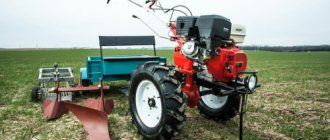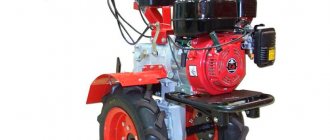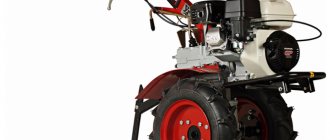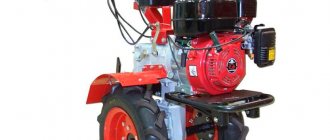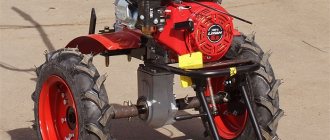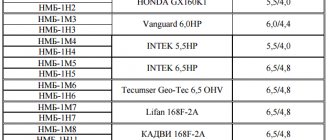Description
Design, repair and maintenance of the Ugra walk-behind tractor are the most frequently asked questions on specialized forums. In this article we will look at these issues in detail.
Motoblocks of the Ugra brand comply with all European standards and safety approvals; they have proven themselves to be reliable and hardy farmer’s helpers. In conjunction with functional attachments they can be used all year round.
The manufacturer is the Russian enterprise “Kaluga Engine” (“KaDvi”), which produces motors, spare parts for tractors, attachments and walk-behind tractors “Ugra” and “Oka”.
What to do if the Ugra walk-behind tractor does not start
We invite you to familiarize yourself with the reasons that affect the launch of the power plant of the Ugra walk-behind tractor:
- Lack of fuel: fill the fuel tank with gasoline.
- Running out of oil: add oil.
- Problem with spark plugs: smoked - clean and rinse in gasoline; if wet - pump and dry, replace the tip; burnt out - replace the spark plug.
- No spark: adjust the gap between the contacts;
- Problems with the magneto: adjust its position if the blades jam; replace if burned.
- The carburetor of the Ugra walk-behind tractor requires repair: if it is clogged, disassemble and clean it; out of order - replace.
- Filters (air and fuel) are clogged: clean or replace.
Maintenance of the Ugra walk-behind tractor
Walk-behind tractor maintenance includes:
- Preparation for field work.
- Daily care after use.
- Scheduled inspections.
- Contacting service centers.
- Preservation of the Ugra walk-behind tractor for long-term storage.
Preparation for use:
- Checking the fuel level in the fuel tank.
- Checking the oil level in the engine crankcase.
- Checking the reliability of available fasteners.
- Tire pressure.
Caring for the unit after use:
- Cleaning the Ugra walk-behind tractor from dust and dirt, clods of earth, oil and gasoline stains.
- Washing the walk-behind tractor with water.
- Dry the car in an open space without direct sunlight.
- Lubrication of components and mechanisms with appropriate lubricants.
Preservation is a period of downtime for which it is necessary to prepare the machine accordingly.
The owner of this heavy equipment must:
- drain the fuel from the gas tank;
- drain the oil from the engine crankcase;
- clean the walk-behind tractor from dirt;
- lubricate components and mechanisms;
- Place the walk-behind tractor under cover in a dry, ventilated place.
Clutch for walk-behind tractor - design and principle of operation
The clutch of absolutely any agricultural machine consists of a number of elements. The design of the mechanism includes:
- Constant control device;
- Master node;
- Driven components.
The design of the control mechanism includes a release lever connected to the pressure disk via a pedal lift and rods.
When the clutch device of the unit is blocked, a signal is generated that is received by the release levers. They, in turn, disconnect the driven disk from the pressure housing, as a result of which the mechanism is turned off. The bearing in the clutch assembly of a modern walk-behind tractor serves to reduce friction, while eliminating contact between the levers rotating around their axis and the completely stationary linkage. The spring is responsible for returning the control mechanisms to their original position. At the same time, the branch is pushed away from the levers to the distance required for final shutdown.
Advantages of Ugra walk-behind tractors
“Ugra” belongs to the class of heavy Russian-made walk-behind tractors. The unit was developed by Kaluga. The factory warranty for the product is given for a period of 24 months.
The machines of this line have proven themselves to be reliable, functional, safe machines that make the farmer’s work easier and reduce the time spent cultivating land.
In addition to its main function - working with soil - the Ugra can be used as a snow blower, a device for collecting and removing garbage, a digger of potatoes and other root crops, and even an earth drill when using the appropriate attachments.
There are many modifications of the Ugra walk-behind tractor, but each of them shares certain features.
Read more about the operational advantages of this series:
- gear reducer and gearbox;
- adjustable steering column (horizontally and vertically);
- two power take-off shafts (allow you to connect additional equipment that is rarely used - pumps, drills, feed crushers);
- powerful engines of domestic or foreign production (depending on the modification: Kadvi, Vanguard, Honda, RobinSubaru, Lianlong, Lifan, DM, Intek);
- power from 5.5 to 7 horsepower (depending on the walk-behind tractor model and engine type).
In addition to the advantages of technical equipment, the Ugra walk-behind tractor also has a number of other advantages, including:
- compactness and ease of assembly and transportation;
- high operating power due to its impressive weight;
The components of the unit include:
- governing bodies,
- transmission,
- power part,
- cultivator,
- wings with fenders,
- opener and hitch, wheels.
Cutters can be added to the kit upon request before purchase (at the buyer's request).
The power part and transmission are linked to each other, the steering part, hitch, coulter, wheels and wings, as well as wheels or a cultivator are attached to them. In some modifications, the kit includes two protective disks for the cutters.
Types of clutch mechanisms for walk-behind tractors
Modern walk-behind tractors differ in their design features. There are different types of clutches that can be equipped with equipment:
- friction clutch. This type is in greatest demand among farmers. Such mechanisms are easy to maintain, they can work for a long time without interruption, and have high efficiency;
- centrifugal clutch. Long-term slippage and rapid wear of spare parts caused the centrifugal clutch to not receive due recognition;
- walk-behind tractor belt clutch. Such a mechanism is not very reliable, has low performance, and wears out quickly when working with powerful engines;
- hydraulic clutch. By pressing the pedal, the main piston begins to move. During its rotation, the lubricating fluid is driven. The pressure from the piston is transferred to the connecting rod, the springs automatically restore the piston to the starting position;
- disc clutch on walk-behind tractors. All elements of the mechanism are very reliable, allowing you to start the equipment smoothly. There are single-disk and multi-disk equipment with almost the same operating principle.
There are dry, air clutch types and those that operate in a bath filled with engine oil.
Run-in
Basic rules for launching, running and operating the Ugra:
- before the first start, make sure that the walk-behind tractor is ready for work - assembled, standing on a flat surface, filled with oil and fuel to the recommended level;
- after the first switch-on, the next 25-30 hours are a break-in period, and during this period it is allowed to load the walk-behind tractor at two-thirds of the power;
- It is advisable to start work at above-zero temperatures; if the walk-behind tractor is used in winter, before turning it on, it is kept in a warm room at above-zero temperatures;
- it is prohibited to change gears without stopping the walk-behind tractor;
- it is necessary to regularly carry out maintenance and replace worn parts of the walk-behind tractor;
- on dense soils, the coulter must be installed with its tip to the ground so that the walk-behind tractor can quickly brake;
- for an urgent stop, use the “Stop” lever;
- Perform the first passes of dense or frozen soils in low gears;
- during the break-in period, you should work with the walk-behind tractor on soils that have been pre-treated;
- After the break-in is completed, change the oil and refuel the walk-behind tractor.
Please note that these rules apply to all Ugra walk-behind tractors, regardless of modification. Before starting use, be sure to read the instructions for the unit.
Review of the Ugra walk-behind tractor, running in video review:
Making a clutch for a walk-behind tractor with your own hands
During continuous operation, clutch parts are in constant motion and wear out, so even the most reliable elements wear out over time.
Over time, you will have to buy new spare parts or make everything yourself. Before making a clutch for a walk-behind tractor, you should acquire the following spare parts:
- flywheel and input shaft (an old gearbox from a Soviet Moskvich is suitable);
- driven pulley with two handles;
- a steering knuckle and a working hub (can be taken from a Tavria car);
- crankshaft (GAZ-69);
- B-profile.
It is worth first considering the drawings of the clutch structure. This will greatly simplify the work.
A homemade clutch is made according to the following scheme:
- The crankshaft is ground down until it touches the internal parts of the equipment;
- The standard hub is mounted on the shaft;
- The place for the bearing is machined on the shaft. The hub is installed without gaps so that the pulley turns smoothly;
- The crankshaft is turned over and the same actions are performed on the other side;
- Six holes are made at equal distances in the pulley using a drill with a five-millimeter drill bit. Ten-millimeter bolts will be screwed into them;
- A pulley is installed above the flywheel, the elements are bolted together. The locations for the holes are marked, taking into account their coincidence with the pre-drilled holes;
- The pulley is pulled out and the corresponding holes are drilled in the flywheel;
- The inner surface of the flywheel and shaft is machined until the parts no longer touch;
- You definitely need a clutch handle for the walk-behind tractor. Take a tube 30 millimeters long and 10 millimeters in diameter, it is attached to a pulley;
- The clutch cable for the walk-behind tractor can be taken from an old chainsaw. It is wound onto a reel.
Change of oil
According to the operating instructions for walk-behind tractors, transmission oil should be: Tсn-10, GOST 23652-79, as well as all grades according to SAE: 80-85W, API: GL3-GL4.
For the engine: TAD-17I, TAP-15V, any oils in accordance with GOST 23652-79, as well as high-quality synthetic or semi-synthetic oils for machine engines.
Changing and adding oil is carried out:
- of necessity;
- during scheduled technical inspections.
Scheduled maintenance frequency: maximum every 100 operating hours.
Unscheduled technical inspections are possible when faults are identified or when it is necessary to disassemble the engine and carburetor. Next, we will look in more detail at the main types of breakdowns of Ugra walk-behind tractors and methods for eliminating them.
Checkpoint diagram
The figures below show a diagram of the gearbox (in longitudinal section) on the Ugra walk-behind tractor.
The following figure shows the gearbox with a longitudinal section along the reverse axis.
It is recommended to perform independent disassembly of the gearbox during the warranty period only at walk-behind tractor service centers. After the warranty period expires, independent maintenance and troubleshooting of the gearbox is allowed.
Classification of clutch mechanisms
According to the existing design features of agricultural machines, they can be equipped with the following types of clutch mechanisms:
- friction type clutch - this type of mechanism is in the highest demand among buyers. Its main advantages include ease of practical use and self-maintenance, as well as high performance and long service life;
- centrifugal clutch - this mechanism is not so popular due to their tendency to slip for long periods of time. The centrifugal clutch is equipped with a large number of rubbing parts that are subject to increased wear. In this regard, the centrifugal clutch is not in such high demand among farmers;
- belt type clutch - the main disadvantages of such units include low performance and extremely low reliability. The belt clutch of a walk-behind tractor quickly becomes unusable, especially if the agricultural unit is equipped with a powerful engine;
- disc type clutch - the design of an agricultural machine may include a single-disc or multi-disc mechanism. The disc clutch on walk-behind tractors is equipped with reliable spare parts, the correct placement of which ensures smooth starting of the walk-behind tractor used on the farm.
This kind of classification allows each buyer to choose the optimal mechanism for their walk-behind tractor in terms of design and characteristics.
Main breakdowns and their causes
The main breakdowns include:
- incomplete disengagement and engagement of the clutch
- extraneous noise when the gearbox is operating;
- violation of free gear shifting, their self-switching off;
- oil leak;
- any extraneous noise of unknown origin.
Possible troubleshooting methods:
- if the gears are not fully engaged/disengaged: strengthen the fastening joints, replace worn parts, adjust the clutch;
- if extraneous noise is detected in the box: replace bearings, worn parts, tighten bolts and nuts of fastenings;
- if gears become difficult or switch off on their own: replace gears, learn how to shift gears correctly, replace a spring or gear shaft;
- if there is an oil leak: replace the cuffs, tighten the nut connections, check the oil level with a dipstick;
- If there is any extraneous noise, you must first identify the source of the noise; tightening the nuts, adjusting the bearings, replacing cuffs and gears can help eliminate it.
Engine and support systems
Most users of walk-behind tractors have to deal with four-stroke air-cooled gasoline engines. These engines have the following systems to ensure their operation:
- A fuel supply system designed for preparing the air-fuel mixture, consisting of a fuel tank with a tap, a fuel hose, a carburetor, and an air filter.
- A lubrication system that ensures lubrication of rubbing parts.
- A starting mechanism (starter) designed to spin the crankshaft. Many engines are equipped with an easy starting mechanism that reduces starting force by using a device on the camshaft that opens the exhaust valve during the compression stroke, thereby reducing compression in the cylinder as the crankshaft spins. Heavy walk-behind tractors are sometimes equipped with electric starters powered by batteries. Some models have electric and manual start. The latter is used as a backup.
- A cooling system that removes heat from the engine cylinder block by a flow of air forced by the flywheel impeller as the crankshaft rotates.
- An ignition system that ensures uninterrupted sparking at the spark plug. A rotating flywheel with a magnetic shoe induces an emf in the magneto, which is converted by an electronic circuit into electrical signals supplied to the spark plug. As a result, a spark jumps between the contacts of the latter, igniting the air-fuel mixture.
- The gas distribution system is responsible for the timely entry of the air-fuel mixture into the engine cylinder and the release of exhaust gases. The gas distribution system includes a muffler designed for targeted release of exhaust gases and noise reduction.
Note that engines are sold with all its systems, and if you have an idea to make a walk-behind tractor with your own hands, then the purchased engine will already have a gas tank, an air filter, a starter, etc.
The figure below shows the Honda GX series engine, model GX200 QX4, widely used in domestically produced walk-behind tractors. The power of the unit is 5.5 hp. It has a horizontal crankshaft and a higher compression ratio, ensuring efficient fuel combustion and low carbon deposits.
Transmission
By type, transmission units (gearboxes and gearboxes) can be gear, belt, chain, or various combinations of both.
Classic gear transmission
, consisting only of cylindrical and bevel gears, is used mainly on heavy walk-behind tractors and some models of medium-sized machines. As a rule, it has a reverse and several lowering steps.
The figure below shows the gear transmission of the Ugra NMB-1 walk-behind tractor, consisting of cylindrical and bevel gears. The engine is rigidly attached to the gearbox, which in turn is rigidly connected to the bevel gear. The design of the NMB-1 walk-behind tractor does not have chain and belt drives, which, according to its developers, are an unreliable link in transmissions due to the tendency to breakage, damage and belt slippage.
The torque from the crankshaft is transmitted to the drive shaft 16 (Gearbox Diagram) of the gearbox and is removed from the bevel gear of the driven shaft 15 by the vertical shaft 6 of the angular gearbox (Angle Gearbox Diagram), which transmits rotation to the hexagonal shaft of the 8 drive wheels. To avoid disruption of the proper operation of the transmission, disassembling the walk-behind tractor transmission is not recommended, as this can lead to disruption of the gear adjustment.
The design of the gearbox is a mechanical two-way with 3 forward gears and 1 reverse. The transmission has two power take-off shafts (A) and (B).
Gear-worm transmissions
, consisting of two gearboxes - an upper gear and a lower worm gear - are usually used on light walk-behind tractors. The engine crankshaft is vertical. Sometimes cars with a gear-worm transmission are equipped with a centrifugal automatic clutch. This design of the walk-behind tractor ensures increased compactness of the unit.
Belt-gear, belt-chain and belt-gear-chain transmissions
are quite common in light and medium-sized walk-behind tractors. The engine rotates the shaft of a gear or chain reducer using a belt drive, which is also a clutch. Gear-chain drives are often implemented in a single crankcase.
In a belt drive, to change the speed of movement of the walk-behind tractor and power take-off, the pulleys may have an additional groove. The advantages of such a transmission include simpler disassembly and assembly of the walk-behind tractor than in the case of a gear transmission.
The figure below shows the V-belt transmission of the GreenField walk-behind tractor model MB-6.5 (with a belt-gear transmission), which, along with transmitting torque and reducing the speed, also performs the functions of a clutch and gearbox (speed shifting).
The clutch function is realized using a tension roller and a control mechanism consisting of a rod and a system of levers that allow you to change the position of the roller, which tensions or loosens the belt and, accordingly, turns on or off the transmission of torque from the engine to the gearbox. Speed shifting is carried out using double-groove pulleys. By moving the belt from one stream to another, different speeds of movement of the walk-behind tractor are obtained.
A similar scheme is implemented in the domestic walk-behind tractor Salyut 5, shown in the figure below. The V-belt drive transmits rotation to the gear reducer of the walk-behind tractor.
As a rule, walk-behind tractor transmissions have power take-off shafts
, ensuring the transmission of torque to the working parts of the machine. According to their type and location in the transmission, power take-off shafts can be independent, located before the clutch and rotating regardless of its state (disengaged or engaged), or dependent, located after the clutch, and synchronous with a specific gear. One walk-behind tractor can have several power take-off shafts - different in type and rotation speed.
Clutch
Structurally, the clutch can be designed in different ways. In the form of a V-belt drive (see above), tensioning or loosening the belt of which using the clutch lever leads to the transmission or cessation of transmission of torque from the engine to the gearbox. Or in the form of a single-disc or multi-disc friction dry or wet (oil) clutch, which is more reliable and is used in most models of walk-behind tractors. Some cars use a much rarer bevel clutch.
The already discussed Ugra walk-behind tractor from Kadvi LLC is equipped with a clutch that is the most traditional in design - a multi-disc friction with a pressure spring, operating in an oil bath. The design of a walk-behind tractor with such a clutch must include a clutch housing into which transmission oil is poured.
The clutch consists of a drive half-clutch 2 (Motoblock clutch diagram), a driven half-clutch 3, a disc spring 4, drive 5 and driven 6 disks, a thrust ring 7. It works as follows. When the clutch lever is released, the disc spring compresses the driven and driven discs, assembled in a package alternately. Due to friction between the disks, torque is transmitted from the engine to the gearbox. When the clutch lever is depressed, the force is transmitted via a cable to clutch release lever 4 (Clutch lever). In this case, clutch fork 2 compresses the spring through the driven coupling half and release bearings, separating the driven disks from the drive ones and stopping the transmission of torque.
Differential
Chassis
In most walk-behind tractors, the distance between the wheels can be changed, this makes it possible to install tracks of different widths. Two main types of wheels are used - conventional pneumatic and weighted metal with wide lugs. Weights can be welded to the wheels or bolted to them. Many designs of metal wheels provide for the fastening of loads of various weights. This allows, if necessary, to increase the weight of the walk-behind tractor to values that provide the necessary grip of the wheels on the ground.
Metal wheels can have a solid rim or be made in the form of two or three narrow hoops connected by lugs. The former have the disadvantage that soil accumulates between the lugs, preventing good adhesion of the wheels to the ground.
Controls
Some controls (carburetor air damper, power take-off shaft, etc.) are located on the corresponding components and assemblies.
Typically, the clutch control lever and the engine emergency stop lever are located on the left steering rod, and the gas handle, wheel drive lever and brake lever (if equipped) are located on the right steering rod. The design of the steering column of walk-behind tractors, as a rule, provides for adjustment of the position of the handles in the horizontal and vertical planes. The figure shows the controls of the SunGarden MF360 walk-behind tractor.
Instructions for the Ugra walk-behind tractor
The instruction is a document that provides the owner with complete information about the device, including the following:
- unit design (with diagrams of main components and descriptions);
- model characteristics;
- first start guides;
- descriptions of running-in;
- list of maintenance stages;
- list of possible problems.
We suggest that you briefly familiarize yourself with the information provided in the instructions.
Motoblock device
“Ugra” consists of the following structural elements:
- four-stroke single-cylinder carburetor engine;
- chassis;
- transmissions;
- walk-behind tractor controls.
Construction of the Ugra walk-behind tractor
Motoblock engine design
The figure shows a cross-section of a gasoline internal combustion engine:
The structure of a four-stroke gasoline engine (Honda) walk-behind tractor: 1 - fuel filters, 2 - crankshaft, 3 - air filter, 4 - part of the ignition system, 5 - cylinder, 6 - valve, 7 - crankshaft bearing.
Let us list the components of the carburetor engine installed on the Ugra walk-behind tractor:
- fuel filters;
- crankshaft;
- Air filter;
- ignition system;
- 4 cylinders;
- valves;
- crankshaft bearings.
A gasoline internal combustion engine is a complex device that includes several systems:
- Fuel supply system. Provides preparation of the fuel-air mixture and consists of the following elements:
- carburetor;
- fuel tank;
- faucet;
- air filter;
- fuel supply hose.
- Trigger mechanism. The starter is part of the starting system; it spins up the engine flywheel and then the crankshaft. Some engine models are equipped with a decompressor, which makes starting the power plant easier, and an electric starter powered by a battery.
- Ignition system of the Ugra walk-behind tractor. Thanks to this system, sparking occurs at the spark plug with a preset amplitude. The necessary conditions for the formation of a spark and ignition of the air-fuel mixture are provided by the following elements:
- flywheel;
- magnetic shoe;
- magneto;
- candle.
We suggest you familiarize yourself with the electronic ignition circuit:
1 - electronic magneto, 2 - screw, 3 - magnetic shoe.
Starting mechanism and ignition system of the walk-behind tractor: 1 - starter handle, 2 - fan housing, 3 - protective casing, 4 - cylinder, 5 - cylinder head, 6 - magneto, 7 - flywheel.
- Lubrication. An internal combustion engine has many rubbing parts, so a lubrication system is necessary for the proper and uninterrupted operation of the power plant.
- Cooling system. The cylinders of the power plant become very hot during operation, and in order to protect the engine from overheating and premature wear, care must be taken to remove heat and cool the cylinders. This task is accomplished by air flows created by the rotation of the flywheel impeller when the crankshaft rotates.
- Gas distribution system. Responsible for the flow of the fuel mixture into the cylinder, as well as for the removal of exhaust gases to the outside. The muffler acts as a gas outlet.
Ugra walk-behind tractor gearbox
Manufacturer of NMB-1 Ugra walk-behind tractors - JSC Kaluga Engine, (CADVI) Kaluga, st. Moskovskaya, 247
Today JSC Kaluga Engine is a modern diversified enterprise, highly mechanized and automated, equipped with unique technological equipment. More than 37 years of production experience is a guarantee of quality and high reliability of products. The development of production at the enterprise is proceeding in several directions. First of all, this is the production of complex and high-tech products.
The history of the enterprise began in 1966, when a new enterprise was created on the basis of one of the workshops of the Kaluga Turbine Plant and the Kaluga branch of the Research Automobile and Automotive Engine Institute - the Kaluga Experimental Motor Plant.
Official website of the manufacturer of the NMB-1 Ugra walk-behind tractor https://www.kadvi.ru
The NMB-1 Ugra walk-behind tractor is a powerful, reliable, safe machine. The best confirmation of quality is a two-year guarantee. In combination with mounted implements, it performs a diverse range of work: cultivating the soil, mowing, spraying, watering, digging and planting potatoes, transporting cargo, removing snow. Two power take-off shafts make the walk-behind tractor universal and make it easy to connect a wide range of additional attachments, such as a water pump.
The gearbox and drive reducer are gear-type, the clutch is made of metal-ceramic discs, which significantly increases the reliability of operation. These design elements are inherent in professional equipment. The absence of drive V-belts completely eliminated the problems associated with them: slipping, jumping off, and breakage. The gearbox has 3 forward and 1 reverse speeds, which optimizes work with trailed and mounted implements.
Speed optimization
| Broadcast | Speed km/h | Soil and attachments |
| 1 | up to 3.61 | Work on heavy soils, potato planter, trailer with load, adapter. |
| 2 | up to 5.88 | Work on light soils, cultivators on heavy soils |
| 3 | until 8.52 | Cultivators on light soils, driving with a trailer on roads |
| back | up to 2.28 | Rotary mower, snow blower. |
The steering column is easily adjustable in vertical and horizontal planes and has vibration protection.
Turning the steering wheel in a horizontal plane allows you to avoid “trampling” the soil during cultivation. “Ugra” is the only Russian walk-behind tractor made in accordance with European safety standards. The control system (red engine stop handle (left handle) black reverse clutch lock lever (right handle) allows you to instantly and safely stop the unit in an emergency. Two power take-off shafts on the gearbox allow stationary work on a wide range of attachments: circular saw , feed crusher, water pump, earth drill and others.
With minimal disassembly, the walk-behind tractor easily fits in the trunk of any passenger car, which makes transportation much easier.
Technical characteristics of the NMB-1 Ugra walk-behind tractor
| Technical Specification Parameter | Parameter value |
| Structural weight (with cultivator/pneumatic wheels), kg | 85/84 |
| Operating weight (with cultivator/pneumatic tires), kg. | 91/90 |
| Shipping weight, kg. | 61 |
| Traction force with pneumatic wheels, kgf (Kn) | 100 (0,98) |
| Traction force with metal wheels, kgf (Kn) | 130 (0,98) |
| Transport gauge, adjustable, mm. | 405, 695 |
| Ground clearance with wheels, mm. | 170 |
| Total weight of the towed trolley, kg. | 350 |
| Wheel tires | 4.0x10 |
| Gap between spark plug electrodes, mm | 0,5…0,7 |
| Travel of the motor control lever on the control and regulation board | Full. The lever should stop in its extreme positions when turning the gas lever |
| Free play of the clutch lever, mm | 3…5 |
| Tire pressure kgf/cm² | 2 |
| Maximum travel speed (pneumatic wheels/lugs), km/h. | |
| 1st gear | 3,61/3,5 |
| 2nd gear | 5,88/5,7 |
| 3rd gear | 8,52/8,25 |
| Reverse | 2,28/2,2 |
Experienced gardeners note that ground clearance of up to 170 mm and a low center of gravity provide high stability and eliminate damage to plants during work. An ergonomic control system and a variety of adjustments make the operator’s work comfortable and minimize harmful effects on the operator, soil and plants.
Types of walk-behind tractors NMB-1 Ugra
| Model | Engine | Power hp |
| Ugra NMB-1N2 | HONDA GX200 | 6.0 hp |
| Ugra NMB-1N5 | Briggs & Stratton | 6.0 hp |
| Ugra NMB-1N9 | Robin Subaru EX 17 PREMIUM | 6.0 hp |
| Ugra NMB-1N11 | KADVI 168F – 2A | 6.5 hp |
| Ugra NMB-1N3 | Vanguard 6.5HP | 6.5 hp |
| Ugra NMB-1N7 | Lifan 168F-2A | 6.5 hp |
| Ugra NMB-1N10 | Robin Subaru EX 21 PREMIUM | 7.0 hp |
| Ugra NMB-1N12 | Greenfield | 6.5 hp |
Here is an excerpt from the user manual, which indicates modifications depending on the installed engine.
The most popular walk-behind tractors with Subaru and Lifan engines.
The difference between the Ugra NMB-1N and NBM-1M modifications is: Caliper (angular gearbox) - Gear ratio - 12.73 - for NMB-1(M). Gear ratio – 25.46 – for NMB-1(N).
Gearbox oil - TSn-10 GOST 23652-79 or any other gear oil corresponding to SAE: 80...85W API: GL3...GL4
Filling volume - 1.7 liters for NMB-1(N) modifications; 1.5 l - for modifications NMB-1(M)
Replacement frequency: first replacement after 30 hours, top up during maintenance, check level every 10 hours, replacement every 100 hours of operation.
